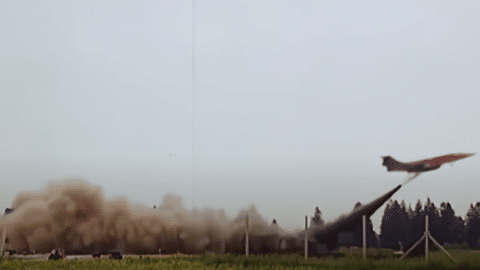
YouTube / Not What You Think
One of the nightmares for the US and its allies during the Cold War was the Soviet Union’s capability to deploy atomic bombs intercontinentally. This meant that an airfield could now be completely destroyed in one hit, grounding the entire fleet and making them unable to retaliate against further attacks.
To solve this problem, many believed that putting a fighter jet on a ramp located at the back of a truck was a good solution. In this setup, the fighter would get launched directly into the air with the help of a rocket booster – a sequence similar to a missile launch.

On January 5, 1954, the US Air Force decided to launch an F-84G Thunderjet with the help of a rocket – this time, with a human pilot inside. This marked the first manned Zero Length Launch or ZELL in history. Bob Turner, the test pilot of the program, said the G-forces during takeoff were similar to what he felt when a plane is catapulted from an aircraft carrier.
Aside from the Thunderjet, the USAF also tried ZELLs with F-100 Supersabres. Tests showed that the F-100 could do the launches while carrying both external fuel tanks and a single nuclear weapon.

And so, with the aircraft now launched, comes the problem of landing.
Zero-Length Launch Mat Landing or ZELMAL was a program that tested the possibility of a zero-length landing. The program tried to accomplish this by using an arresting cable, a tailhook, and an inflatable rubber mat for landings where no airfields are nearby.
Only two manned landings were performed using ZELMAL, with both pilots suffering back or neck injuries as a result. In the absence of a safer landing option, the pilot would have been forced to eject from the aircraft.

As a result, the ZELMAL and ZELL programs were later canceled by all nations.